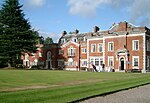St Helen's Church, Waddington
Austin and Paley buildingsChurch of England church buildings in LancashireChurches in Ribble ValleyDiocese of BlackburnEnglish Gothic architecture in Lancashire ... and 3 more
EngvarB from September 2013Gothic Revival architecture in LancashireGrade II* listed churches in Lancashire

St Helen's Church is in the village of Waddington, Lancashire, England. It is an active Anglican parish church in the deanery of Whalley, the archdeaconry of Blackburn, and the Diocese of Blackburn. Its benefice is united with that of St Catherine, West Bradford. The church is recorded in the National Heritage List for England as a designated Grade II* listed building.
Excerpt from the Wikipedia article St Helen's Church, Waddington (License: CC BY-SA 3.0, Authors, Images).St Helen's Church, Waddington
Beechthorpe Avenue, Ribble Valley Waddington
Geographical coordinates (GPS) Address External links Nearby Places Show on map
Geographical coordinates (GPS)
| Latitude | Longitude |
|---|---|
| N 53.8899 ° | E -2.4144 ° |
Address
St Helen
Beechthorpe Avenue
BB7 3HT Ribble Valley, Waddington
England, United Kingdom
Open on Google Maps










